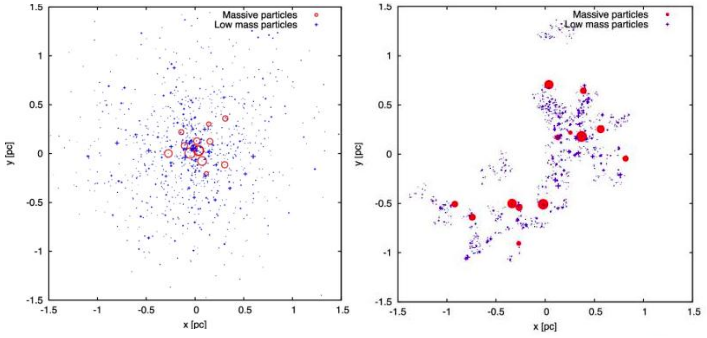Mass segregation in regions of young star formation
Star clusters are objects that contain hundreds or thousands of stars in a small spherical region in space. Some ancient objects of this category (globular clusters, as old as the Universe) can even contain several million stars. If we look at these objects very closely, we detect that in these objects the most massive stars or, in the case of the oldest clusters, the most massive stellar remnants (neutron stars, for example) are concentrated in their centres. We call this mass segregation. This concept is well known and well explained by standard dynamic theories. Over time, each star system should evolve into a state of mass segregation.
Observations of very young star clusters find that these objects show signs of mass segregation. Since these groups are too young for standard theory to produce such segregation, we need to find a new process to explain segregation in these very young objects. Possible explanations could be the influence of binary stars (pair of stars that are associated describing orbits around each other as a result of their mutual gravitational attraction) or the simple explanation that these star clusters are already born in a state of segregation of masses, that is, the most massive stars are born in the central region, which is the densest region.
Other observations and theoretical simulations show that young stars are born in groups and filaments and not as an almost spherical entity. They evolve in a short time to an almost spherical state, but do not start as such. Now the easy explanation again seems to fail, since such entities do not have a dense centre.
"Our studies are composed of simple simulations of groups and filaments with different locations for the most massive stars. They could be formed randomly distributed throughout the star-formation region, in fact, they could form in the most central area or even further away from the centre. Our results show that, regardless of the initial location, once the stars have been resettled in a more spherical configuration, the more massive objects will reside in the centre. This implies that no matter where the massive stars are born, once we see an object, we would call it a star cluster, it is automatically segregated en mass. On the other hand, these findings imply that, if we see a group segmented in mass, we still do not have the possibility to deduce where the most massive stars were born," says Dr. Michael Fellhauer.
Astronomers from the University of Concepción conducted the research entitled: "How fast is segregation of masses in clusters of young stars formed hierarchically?", A work published in Monthly Notices of the Royal Astronomical Society (MNRAS 2017, vol.472, pp. 465-474). The research was led by the astronomer R. Dominguez, together with M. Fellhauer, M. Blaña, J.P. Farias and J. Dabringhausen.
For more information, consult the website: http://theory-starformation-group.cl
The full original article can be downloaded here.

Comunicaciones Departamento de Astronomía UdeC




